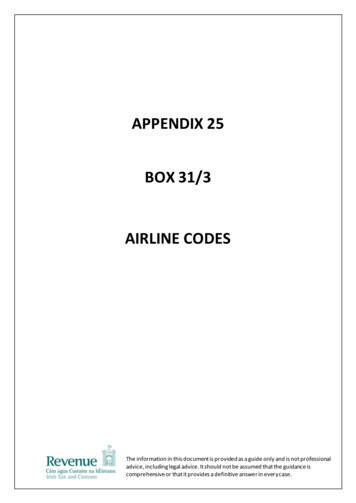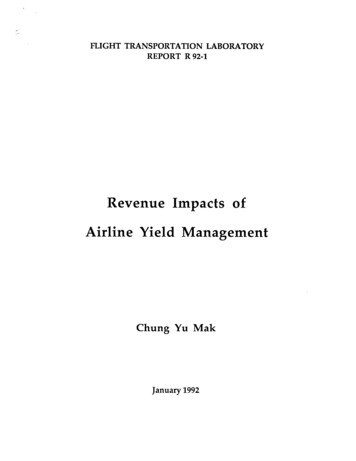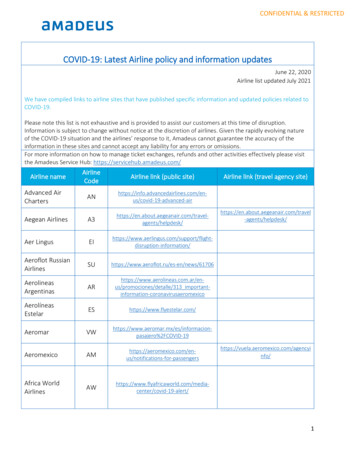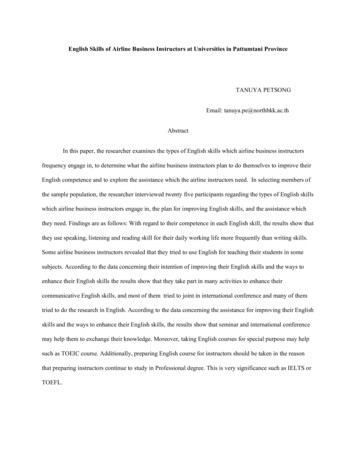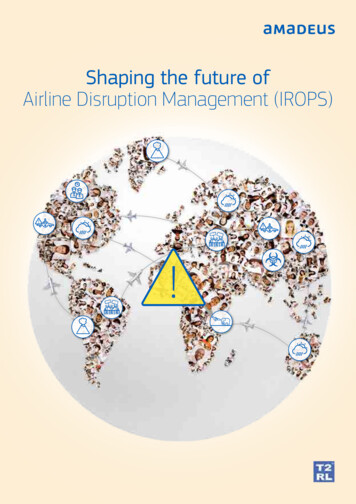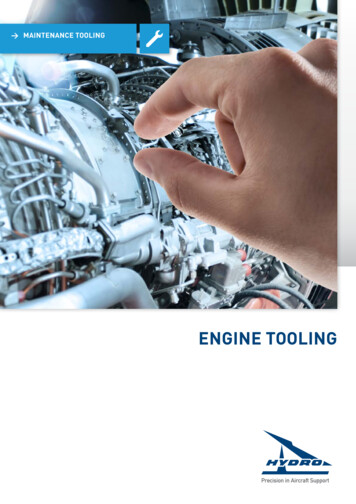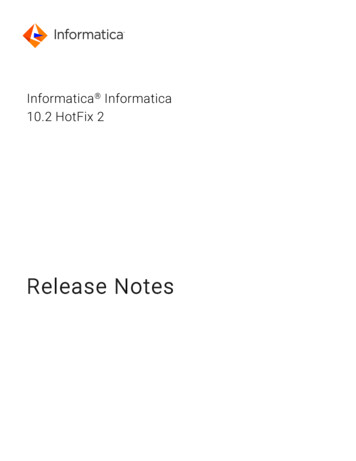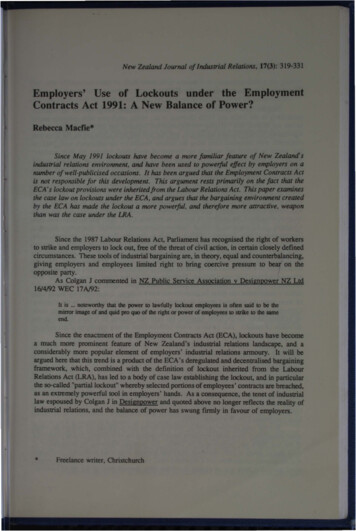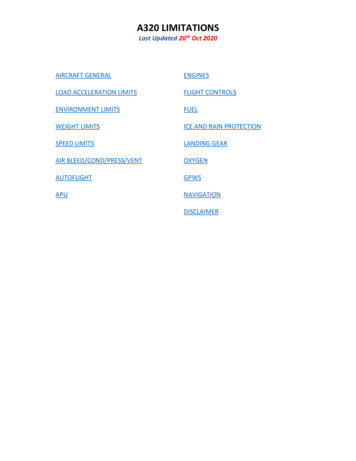
Transcription
A320 LIMITATIONSLast Updated 26th Oct 2020AIRCRAFT GENERALENGINESLOAD ACCELERATION LIMITSFLIGHT CONTROLSENVIRONMENT LIMITSFUELWEIGHT LIMITSICE AND RAIN PROTECTIONSPEED LIMITSLANDING GEARAIR TIONDISCLAIMER
AIRCRAFT GENERAL
FLIGHT MANEUVERING LOAD ACCELERATION LIMITSClean configuration: -1 g to 2.5 gOther: 0 g to 2 gENVIRONMENT LIMITSRunway slope (mean): 2 %Runway altitude: 9 200 ftNominal runway width: 148 feetMinimal runway width for AP-BLU, BLV, BLW: 98 feetMaximum demonstrated crosswind (takeoff and landing): 38 knots (gust included)Maximum tailwind for Takeoff – BLY & BLZ 15 knots, Others 10 knots.Maximum tailwind for Landing – BLY & BLZ 15 knots, Others 10 knots.For landing with a tailwind greater than 10 knots, use FLAPS FULL only.Maximum tailwind for Automatic Landing and Rollout 10 knots.Maximum wind for passenger door operation is 65 kt.Maximum wind for FWD and AFT cargo door operation is 40 knots (or 50 knots, if the aircraft nose is into the wind, or if the FWD andAFT cargo doors are on the leeward side). The FWD and AFT cargo doors must be closed before the wind speed exceeds 65 kt.WEIGHT LIMITATIONSWeight Limits (Kgs)MSN 21MSN 22BLB – BLC –BLDMSN 29BLY –BLZMSN 27BLU – BLV – BLWMSN 30BLA – BLS – BLTApprox. values tokeep in mindMax Taxi77,40075,900 / 73,90077,400 / 75,900 / 73,900400 above MTOWMTOW (brake release)77,00075,500 / 73,50077,000 / 75,500 / 73,50075 tonsMLW64,50066,00066,00065 tonsMZFW61,00062,50062,50060 tonsMin Weight37,23037,23037,23037 tonsIn exceptional cases (in flight turn back or diversion), an immediate landing at weight above maximum landing weight is permitted,provided the pilot follows the overweight landing procedure. For dual or multiple max weights, a/c placard reflects the current limit.
SPEED LIMITSMINIMUM CONTROL SPEEDS VMCL – 108 Knots for BLY and BLZ and 113 Knots for others. VMCA – 110 Knots IAS at Sea Level, decreasing with increase in altitude. VMCG – 111 Knots IAS at Sea Level with CONF 1 F, decreasing with increase in altitude and flap setting. For AP-BLY and AP-BLZ, same as above except the speed is 105 instead of 110 for VMCA and 106 instead of 111 for VMCG. So as a rule of thumb 115 KNOTS IS THE RED LINE for all models and for all minimum control speeds. For exact values see the table given in FCOM Limitations – LIM-AG-SPD.MAXIMUM FLAPS / SLATS SPEEDSGEAR DOWN SPEEDS VLE – 280 / 0.67VLO Extension – 250 / 0.60VLO Retraction – 220 / 0.54TYRE SPEED: Maximum Ground Speed – 195 KnotsWIPERS IN USE: Max Speed – 230 Knots (applicable when the wipers are sweeping).COCKPIT WINDOW OPEN: Max Speed – 200 Knots.TAXI SPEED:If takeoff weight 76,000 kg – Do not exceed a taxi speed of 20 knots during a turn.
AIR BLEED, CONDITIONING, PRESSURIZATION AND VENTILATIONWith passengers on board, it is not recommended to exceed 20 min without air conditioning supply.APU WITH HP GROUND UNITDo not use HP ground unit when APU supplies bleed air to avoid bleed system damage.AIR-CONDITIONING WITH LP GROUND UNITDo not use conditioned air simultaneously from packs and LP ground unit.AVIONICS VENTILATIONDuring ground operations, limit the aircraft electric power supply with avionics ventilation system in normal configuration as follows:OAT 49 C No Limitation. Above that just go home or open FCOM LIM AIR (For 55 C – 2 hours, 60 C – 1 hour & 64 C – ½ hour).CABIN PRESSUREMaximum positive differential pressure: 9.0 PSIMaximum negative differential pressure: -1 PSISafety relief valve setting: 8.6 PSIRAM AIR INLETOpen if Differential Pressure 1psi.AUTOFLIGHTAUTOPILOT FUNCTIONMinimum values for use of autopilot:Takeoff with SRS mode: 100 feet AGL and at least 5 seconds after liftoff.ILS CAT I: 160 feet AGLILS CAT II or CAT III: 0 ft AGLIn approach with FINAL APP, V/S or FPA mode: 250 feet AGLPAR approach (Precision Approach Radar): 250 ft AGLCircling Approach: 500 feet AGL for CAT C and 600 feet AGL for CAT DAfter Manual Go-around: 100 ft AGLAll other phases: 500 ft AGL. (The AP or FD in OP DES or DES mode can be used in approach. However, its use is only permitted if theFCU selected altitude is set to, or above, the higher of the two: MDA/MDH or 500 ft AGL)Note: So basically 100 for takeoff and go-around, 160 for Precision approaches, 250 for non-precision approaches and 500 otherwise.
FLIGHT MANAGEMENT FUNCTIONDEGRADED SITUATIONIf GPS PRIMARY LOST is displayed, the navigation accuracy remains sufficient for RNP operations provided that, the RNP value ischecked or entered on the MCDU and HIGH ACCURACY is displayed.PREREQUISTES FOR USE OF NAV MODE AT TAKEOFF GPS Primary availableFMGS Takeoff Updating CheckedPREREQUISTES FOR USE OF NAV MODE IN TERMINAL AREA GPS PRIMARY is available, orHIGH Accuracy is displayed, and the appropriate RNP is checked or entered on the MCDU, orFMS navigation is cross-checked with NAVAID Raw DataAPPROACH BASED ON RADIO NAVAIDSA NAVAIDS approach performed in NAV, APP NAV or FINAL APP, with AP or FD engaged: GPS PRIMARY available – NAVAID unserviceable or airborne equipment inoperative – Approval Required. GPS PRIMARY not available – NAVAID and airborne equipment serviceable – Monitor Raw Data during approach.Note: FLS is the recommended managed lateral and vertical guidance mode for radio navaids approach.
RNAV APPROACH1)AN RNAV(RNP) APPROACH: GPS PRIMARY available – RNAV(GNSS) approach may be performed. GPS PRIMARY not available – RNAV(GNSS) approach may be performed if:oooRadio NAVAID coverage supports RNP value.HIGH accuracy is displayed.Approval obtained.Note: FLS is the recommended managed lateral and vertical guidance mode for RNAV approach2)APPROACH BASED ON RADIO NAVAIDS:VOR / DME flown with FLS F-APP Displayed on FMA – Navaids & airborne equipment may be inoperative subject to approval. F-APP Raw Capability Displayed on FMA – Navaids & airborne equipment must be operative tuned and monitored.ILS (G/S Out) or LOC APP flown with LOC and F-GS mode of FLS. F-APP Displayed on FMA – Ref navaids for vertical path validation must be tuned and checked at FDP. F-APP Raw Capability Displayed on FMA – Ref navaids for vertical path validation must be tuned and checked atFDP & monitored during approach.3)RNAV(GNSS) APPROACH With LNAV Minimum & F-APP capability Displayed on FMA – MAY be flown with FLSWith LNAV/VNAV Minimum & F-APP capability Displayed on FMA – MUST be flown with FLSNote: The RNAV(GNSS) approach limitations and procedures must be used to perform an RNAV approach for which the GNSSis not required.NON-PRECISION APPROACHES WITH ENGINE-OUTFor AP-BLY and BLZ: If one engine is inoperative, it is not permitted to use the autopilot to perform NPAs in: FINAL APP mode, orNAV V/S, orNAV FPA.Only FD use is permitted.ILS CAT IIMinimum decision height: 100 ft AGLAt least one autopilot must be engaged in APPR mode.CAT 2, CAT 3 SINGLE or CAT 3 DUAL must be displayed on the FMA.For manual landing, the autopilot must be disengaged not later than 80 ft AGL.
SPECIAL AUTHORIZATION OR OTHER THAN STANDARD CAT IISame as ILS CAT II except: With HUD: use HUD to monitor the approach and perform an automatic or manual landing. Without HUD: Must perform an automatic landing.BASIC DEFINITIONSFail-Operational Automatic Landing System:An automatic landing system is fail-operational if, in the event of a failure, the approach, flare and landing can be completed by theremaining part of the automatic system. In the event of a failure, the automatic landing system will operate as a fail-passive system.The following are typical arrangements:(i) Two monitored automatic pilots, one remaining operative after a failure.(ii) Three automatic pilots, two remaining operative (to permit comparison and provide necessary failure detection and protection)after a failure.Fail-Passive Automatic Landing System:An automatic landing system is fail passive if, in the event of a failure, there is no significant out-of-trim condition or deviation of flightpath or attitude but the landing is not completed automatically. For a fail-passive automatic landing system the pilot assumes controlof the aircraft after a failure.The following are typical arrangements:(i) A monitored automatic pilot in which automatic monitors will provide the necessary failure detection and protection.(ii) Two automatic pilots with automatic comparison to provide the necessary failure detection and protection.Fail-Operational Hybrid Landing System:A system which consists of a primary fail-passive automatic landing system and a secondary independent guidance system enablingthe pilot to complete a landing manually after failure of the primary system. A typical secondary independent guidance system consistsof a monitored head-up display providing guidance which normally takes the form of command information, but it may alternativelybe situation (or deviation) information.Alert Height:It is a specified radio height, based on the characteristics of the aeroplane and its fail-operational landing system. In operational use,if a failure occurred above the alert height in one of the required redundant operational systems in the aeroplane (including, whereappropriate, ground roll guidance and the reversionary mode in a hybrid system), the approach would be discontinued and a go-aroundexecuted unless reversion to a higher decision height is possible. If a failure in one of the required redundant operational systemsoccurred below the alert height, it would be ignored and the approach continued.
ILS CAT III SINGLE (FAIL PASSIVE)Minimum decision height: 50 ft AGLA/THR must be used in selected or managed speed.At least one autopilot must be engaged in APPR mode.CAT 3 SINGLE or CAT 3 DUAL must be displayed on the FMA.ILS CAT III DUAL (FAIL OPERATIONAL)A/THR must be used in selected or managed speed.Both autopilots must be engaged in APPR mode.CAT 3 DUAL must be displayed on the FMA.Alert height: 100 ft. CAT III with DH:o Minimum Decision Height: 20 ft CAT III without DH:o Minimum RVR: 75mENGINE OUT CAT II AND CAT III SINGLE APPROACHOnly approved in: Configuration FULL. Engine-out procedures completed before reaching 1,000 ft.MAXIMUM WIND CONDITIONS FOR CAT II / III AUTOMATIC APPROACH, LANDING AND ROLLOUT Headwind: 30 knotsTailwind: 10 knotsCrosswind: 20 knotsWind limitation above is ATC reported wind. If wind on ND exceeds the above limits but the tower report is within the above limits,then autopilot can remain engaged. If tower reports is beyond these limits then only CAT I automatic approach without autoland canbe performed.AUTOMATIC LANDING CONFIGURATIONApproved in CONF 3 and CONF FULL for: ILS /MLS CAT II and CAT III. GLS CAT I.
AUTOMATIC LANDING DEMONSTRATIONAutomatic landing is demonstrated: With CAT II/III ILS/MLS beam and CAT I GLS Beam. With slope angle within –2.5 and –3.15 . For airport elevation:oAt or Below 9200 ft for AP-BLU, BLV, BLW, BLA, BLS, BLT.oAt or Below 2500 ft for AP-BLB, BLC, BLD, BLY, BLZ.AUTOMATIC LANDING WITH AUTOMATIC ROLLOUT Automatic landing is not allowed below -1 000 ft pressure altitude. Automatic rollout performance has been approved on dry and wet runways. During automatic rollout with one engine inoperative or one thrust reverser inoperative, the flight crew can use the remainingthrust reverser, provided that the wind does not exceed the maximum wind conditions for automatic rollout.AUTOLAND IN ILS CAT IAutomatic landing in CAT I or better weather conditions is possible on: CAT I ground installations. CAT II/III ground installations when ILS/MLS sensitive areas are not protected.However, following precautions are required: Airline must check the ILS/MLS beam quality and the effect of the terrain profile (especially 300 m) before the runwaythreshold. It should have no adverse effect on AP/FD guidance. Aircraft weight should be below the maximum landing weight. FMA should show CAT2 capability at least and crew should use CAT II/III procedures. Crew awareness that LOC or G/S beam fluctuations may occur. Be prepared to disconnect the autopilot in case of unsatisfactory guidance. Visual references are obtained at an altitude appropriate for the CAT I approach, if not then go-around.Note: For a list of airports where autoland is not allowed, see FCOM LIM-AFS-20.
APUAPU OIL QUANTITYAPU may be operated with LOW OIL LEVEL ECAM advisory. Maintenance action is required within next 10 h of APU operation.APU STARTAfter 3 consecutive start attempts, wait 60 min before a new start attempt.APU ROTOR SPEEDMaximum N: 107 %APU automatically shuts down at 107 % N speed, that appears on the ECAM. This corresponds to an actual N speed of 105% for APBLB, BLC, BLD or 106% for others.APU EGT (AP-BLB, BLC, BLD)Max EGT for APU start: Below 25 000 ft: 900 C Above 25 000 ft: 982 CMaximum EGT for APU running: With 5 seconds confirmation for shutdown: 682 C For Immediate shutdown: From 700 – 742 CAPU EGT (Other than AP-BLB, BLC, BLD)Max EGT for APU start: Below 35 000 ft: 1090 C Above 35 000 ft: 1120 CMaximum EGT for APU running: 675 CAPU START/SHUTDOWN DURING REFUELING/DEFUELINGPermitted with the following restrictions: APU failed to start – Do not start again. APU automatic shutdown – Do not start again. Fuel spill occurs – Perform a normal APU shutdown.
APU BLEEDMax altitude to assist engine start: 20,000 ftMax altitude for air conditioning & pressurization: Single Pack Operation:oAP-BLB, AP-BLC, BLD: 20,000 ftoOther than AP-BLB, BLC, BLD: 22,500 ftDual Pack Operation: 15,000 ft.Use of APU bleed air for wing anti-ice is not permitted.ENGINESTHRUST / EGT LIMITSTakeoff (TOGA, FLEX, DERATES) or Go Around: EGT: 950oC Time Limit:o All Engine Operative: 5 minso One Engine Inoperative: 10 minsMCT: EGT: 915oC. Time: UnlimitedStarting: EGT 725oC
SHAFT SPEEDSN1 max: 104 % (ambient conditions / bleed configuration may limit N1 to a lower value).N2 max: 105 %OILMax continuous temperature: 140 CMax transient temperature (15 min): 155 CMinimum starting temperature: -40 CMinimum temperature for takeoff: -10 CMinimum oil quantity: 9.5qt Estimated Consumption (average consumption is 0.5 qt/h)STARTERAuto start with up to 3 start attempts is 1 cycle.Between successive cycles – 20 seconds pause (for auto or manual ground starts).After 4 failed cycles – 15 min cooling period.Starter must not be run when N2 is above 20 % (i.e. no running engagement of starter).REVERSE THRUSTIt is not permitted to select reverse thrust in flight (oh really! I didn’t know that).
It is not permitted to back up the aircraft with reverse thrust.No Max reverse below 70 kt (Idle reverse permitted down to aircraft stop).REDUCE THRUST TAKEOFFFlex Temperature: Upper Limit:o ISA 53oC (25 % thrust reduction).o ISA 70oC (for AP-BLY and BLZ) Lower Limit: TREF & OAT.Permitted with inoperative items if associated performance shortfall has been applied.Not permitted on contaminated runways.DERATED TAKEOFFDerated takeoff permitted regardless of the runway condition (dry, wet, or contaminated).FLEX not permitted in association with derated takeoff.TOGA thrust not permitted when a derated takeoff is performed, except when requested by an abnormal/emergency procedure.FLIGHT CONTROLSMaximum operating altitude with flaps and/or slats extended is 20,000 ft.Rapid and large alternating control inputs, especially in combination with large changes in pitch, roll or yaw (e.g. large sideslip angles)may result in structural failures at any speed.FUELJET A1 – TEMPERATURE LIMITS: Max: 54oC Min: -43oCNote: The above values are applicable if fuel is not mixed with some other types. For other fuel types see FCOM-LIM-FUEL.
Approx. Quantity for Outer Tank is 700 Kgs and Inner Tank is 5500 Kgs
MINIMUM QUANTITY FOR TAKEOFF 1500 KG WING TK LO LVL warning must not be displayed on ECAM for takeoff.FUEL MIXABILITYVarious types of fuel can be mixed in all proportions. The freezing point of a fuel mixture varies, based on non-linear laws.ICE AND RAIN PROTECTIONICING CONDITIONS OAT / TAT 10oCVisible Moisture – Fog (visibility 1600m), Clouds, Rain, Snow, Sleet, Ice CrystalsRamp, Taxiways and Runways with – Standing Water, Snow, SlushSEVERE ICING Ice accumulation on the airframe reaches approximately 5 mm or more.TAKEOFF LIMITATIONS ON CONTAMINATED RUNWAYSTakeoff is not recommended on the following runway conditions: Wet iceWater on top of Compacted SnowDry Snow or Wet Snow over Ice
LANDING GEARBRAKING SYSTEM Not designed to hold the aircraft in a stationary position with high thrust level. Max brake temperature for takeoff (fans off): 300oC Towing and pushback: Max NWS angle 95o Towbarless towing and pushback: Max NWS Angle 85o Taxing with handwheels: Max NWS 75oTAXI WITH DEFLATED TIRESTo vacate the runway/taxi at low speed: Max 1 tire per gear deflated (consider three gears): Max taxi speed during turn: 7 knots. Two tires deflated on the same main gear (maximum one main gear): Max taxi speed: 3 knots. Maximum NWS angle: 30 TAXI WITH DAMAGED TIRESIf tire damage is suspected: Ask for aircraft inspection prior to vacating the runway/taxiway. Suspecting that a tire burst may damage the landing gear: Maintenance action is due.OXYGENMINIMUM FLIGHT CREW OXYGEN PRESSURESee the table given in FCOM LIM-OXY (2nd Last Chapter PDF Page #3995).GPWS Aircraft navigation is not to be predicated on the use of the terrain display. For runways not incorporated in the predictive GPWS database:o 15 nm short of airfield – TERR Pb OFFProcedures identified to cause spurious terrain alerts:o15 nm short of airfield – TERR Pb OFF
NAVIGATIONINERTIAL REFERENCE SYSTEMDisclaimer: "A320 Limitations" are personal notes of the undersigned for training only. These notes do not sanction any pilotto violate his/her Company's Standard Operating Procedures, Aircraft Manuals or Manufacturer's Recommendations.
FLIGHT MANEUVERING LOAD ACCELERATION LIMITS Clean configuration: -1 g to 2.5 g Other: 0 g to 2 g ENVIRONMENT LIMITS Runway slope (mean): 2 % Runway altitude: 9 200 ft Nominal runway width: 148 feet Minimal runway width for AP-BLU, BLV, BLW: 98 feet Maximum demonstrated crosswind (takeoff and landing): 38 knots (gust included)



